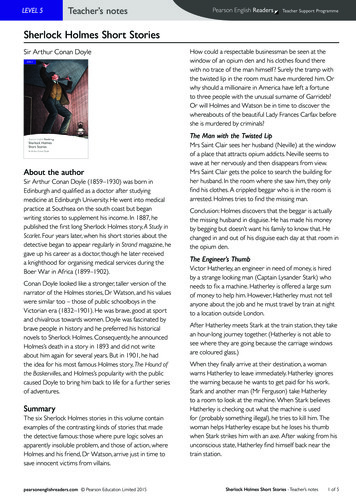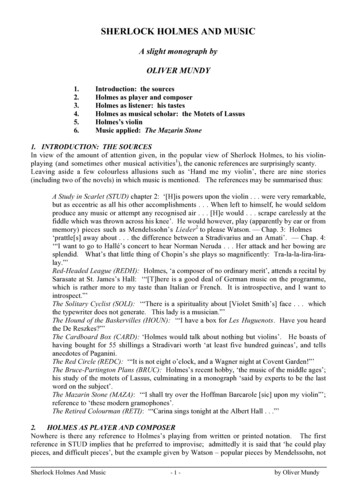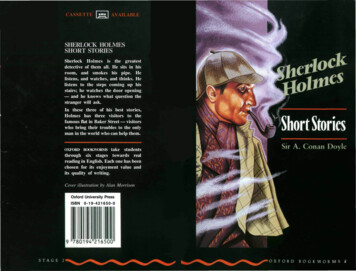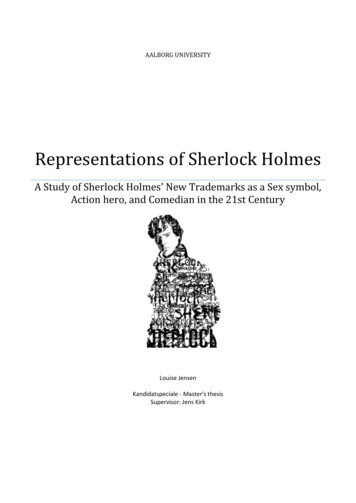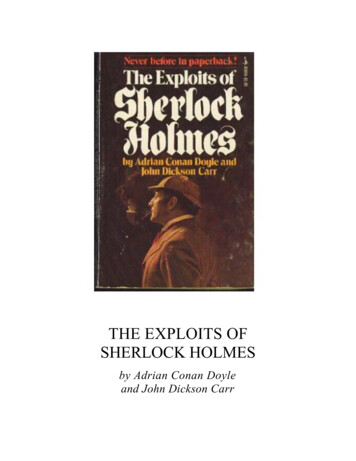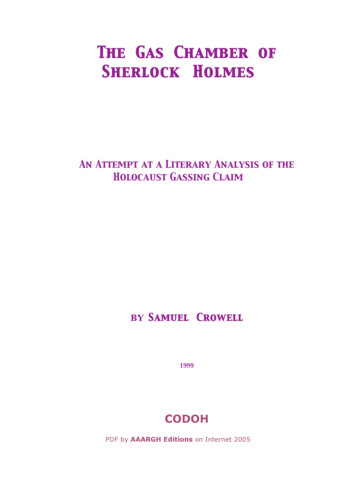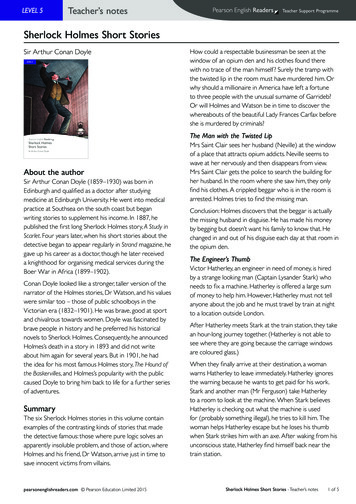
Transcription
level 5Teacher’s notesTeacher Support ProgrammeSherlock Holmes Short StoriesSir Arthur Conan DoyleHow could a respectable businessman be seen at thewindow of an opium den and his clothes found therewith no trace of the man himself? Surely the tramp withthe twisted lip in the room must have murdered him. Orwhy should a millionaire in America have left a fortuneto three people with the unusual surname of Garrideb?Or will Holmes and Watson be in time to discover thewhereabouts of the beautiful Lady Frances Carfax beforeshe is murdered by criminals?The Man with the Twisted LipAbout the authorSir Arthur Conan Doyle (1859–1930) was born inEdinburgh and qualified as a doctor after studyingmedicine at Edinburgh University. He went into medicalpractice at Southsea on the south coast but beganwriting stories to supplement his income. In 1887, hepublished the first long Sherlock Holmes story, A Study inScarlet. Four years later, when his short stories about thedetective began to appear regularly in Strand magazine, hegave up his career as a doctor, though he later receiveda knighthood for organising medical services during theBoer War in Africa (1899–1902).Conan Doyle looked like a stronger, taller version of thenarrator of the Holmes stories, Dr Watson, and his valueswere similar too – those of public schoolboys in theVictorian era (1832–1901). He was brave, good at sportand chivalrous towards women. Doyle was fascinated bybrave people in history and he preferred his historicalnovels to Sherlock Holmes. Consequently, he announcedHolmes’s death in a story in 1893 and did not writeabout him again for several years. But in 1901, he hadthe idea for his most famous Holmes story, The Hound ofthe Baskervilles, and Holmes’s popularity with the publiccaused Doyle to bring him back to life for a further seriesof adventures.SummaryThe six Sherlock Holmes stories in this volume containexamples of the contrasting kinds of stories that madethe detective famous: those where pure logic solves anapparently insoluble problem, and those of action, whereHolmes and his friend, Dr Watson, arrive just in time tosave innocent victims from villains.pearsonenglishreaders.com Pearson Education Limited 2015Mrs Saint Clair sees her husband (Neville) at the windowof a place that attracts opium addicts. Neville seems towave at her nervously and then disappears from view.Mrs Saint Clair gets the police to search the building forher husband. In the room where she saw him, they onlyfind his clothes. A crippled beggar who is in the room isarrested. Holmes tries to find the missing man.Conclusion: Holmes discovers that the beggar is actuallythe missing husband in disguise. He has made his moneyby begging but doesn’t want his family to know that. Hechanged in and out of his disguise each day at that room inthe opium den.The Engineer’s ThumbVictor Hatherley, an engineer in need of money, is hiredby a strange looking man (Captain Lysander Stark) whoneeds to fix a machine. Hatherley is offered a large sumof money to help him. However, Hatherley must not tellanyone about the job and he must travel by train at nightto a location outside London.After Hatherley meets Stark at the train station, they takean hour-long journey together. (Hatherley is not able tosee where they are going because the carriage windowsare coloured glass.)When they finally arrive at their destination, a womanwarns Hatherley to leave immediately. Hatherley ignoresthe warning because he wants to get paid for his work.Stark and another man (Mr Ferguson) take Hatherleyto a room to look at the machine. When Stark believesHatherley is checking out what the machine is usedfor (probably something illegal), he tries to kill him. Thewoman helps Hatherley escape but he loses his thumbwhen Stark strikes him with an axe. After waking from hisunconscious state, Hatherley find himself back near thetrain station.Sherlock Holmes Short Stories - Teacher’s notes 1 of 5
level 5Teacher’s notesTeacher Support ProgrammeSherlock Holmes Short StoriesConclusion: Holmes decides that the machine is usedto press money and that an unconscious Hatherley wasprobably carried away from danger by the woman andFerguson. The train station was near the house butHatherley had been tricked into thinking it was far away.The house burned down in a fire that night, probablybecause of a lamp that Hatherley left by the machine. Thethree from the house get away with boxes of forged coins.The PatientDr Trevelyan set up a private medical practice in his home,with the help of a stranger, Mr Blessington. In exchange,Blessington stayed at the house and received a percentageof the doctor’s earnings. Trevelyan came to Holmes whenBlessington became crazy with fear. His anxiety startedwhen he heard about a recent robbery. (Blessington keptall his money in a metal box in his room because he didn’ttrust banks.)Trevelyan started treating a patient who introducedhimself as a Russian lord. He came with his son. Blessingtonwas out for a walk when the man was being examined.When Blessington returned, he saw footprints in his room.Someone had been in there but nothing had been taken.Holmes asked Blessington who the men were and whythey were his enemies. When Blessington said he didn’tknow them, Holmes told him he needed to tell thetruth and left. The next day, Trevelyan told Holmes thatBlessington had hung himself.Conclusion: Holmes figured out that 15 years before, thetwo men and Blessington had been part of a group offour robbers. Blessington had helped the police and wasset free, while one of the men was hanged. The othertwo (who had disguised themselves as the patient andson) had gone to prison. Once free, they came to punishBlessington. It seemed that they put Blessington on trial,found him guilty, and hanged him.The Disappearance of Lady Frances CarfaxWatson is sent to Switzerland to look for Lady FrancesCarfax, an unmarried woman travelling alone but who hasnot been heard from for weeks. While she is not rich, shealways travels with her unique (and valuable) jewellery.She had been seen talking with a wild-looking Englishmanin Lausanne, Switzerland.Then in Baden-Baden, Germany, she had met a man(Dr Schlessinger) and his wife. The doctor, a religious man,had become ill and Lady Frances had helped the doctor’swife take care of him. She had left with both of them forEngland. The hotel manager told Watson that a strangeEnglishman (likely the one she had seen in Lausanne) hadasked about her.Watson talks with Lady Frances’s maid (Marie Devine) inMontpellier. Devine had always been loyal to Lady Frances.However, she had left Lady Frances in Baden-Baden whenLady Frances accused her of stealing from her. Devinetold Watson that she thought Lady Frances was tryingto escape from the strange Englishman. Just then, shesees him walking past them. Watson tries to talk to theEnglishman but when Watson mentions Lady Frances’sname, the man gets in a fight with him. Watson is saved byHolmes (who is there in disguise) and explains to him thatthe Englishman is actually an old friend of Lady Frances’s(Philip Green) who had been in South Africa earningenough money so he could marry her.They discover that the doctor who Lady Frances istravelling with is actually ‘Peters the Priest’, a man knownfor robbing lonely women with the help of a woman whopretends to be his wife. Holmes, Watson and Green findthe location of the evil couple in London by tracking thesale of some old jewellery through a pawn shop.Conclusion: They find that the evil man and woman havearranged for Lady Frances to be buried in an extra deepcoffin along with an elderly woman who has died. Theybreak open the coffin and find Lady Frances who is stillalive.The Three GarridebsAn old man (Nathan Garrideb), who spends most ofhis days at home with his collection of things, contactsHolmes. Nathan has heard from an American lawyer(John Garrideb) that he could become rich. That lawyermeets with Holmes and explains that a rich Americanman named Alexander Hamilton Garrideb had died andleft a strange condition in his will. Alexander said that ifthree adult males could be found with the unusual nameof Garrideb, then these three men would then receive hisproperty (worth five million dollars each).The lawyer says he has found a third Garrideb (Howard)in England and asks Nathan to travel by train to meet thisman and explain the situation. While Nathan does notwant to leave home, Holmes persuades him to go.pearsonenglishreaders.com Pearson Education Limited 2015Sherlock Holmes Short Stories - Teacher’s notes 2 of 5
level 5Teacher’s notesTeacher Support ProgrammeSherlock Holmes Short StoriesConclusion: Holmes and Watson wait in the old man’shouse, and after some time the lawyer breaks in. Hepushes away a table, lifts up the floor covering, and climbsinto a hole underneath. They are able to stop the lawyerbut not before he shoots Watson in the leg. Holmesdiscovers a press for printing money in the hole. Thelawyer was actually ‘Killer Evans’.Years before, he had shotthe man who owned the printing press in the house nowoccupied by Nathan. Evans served time in prison and hadwaited for his chance to access the house to obtain theprinting press. But first, he had to get Nathan out of thehouse.Wisteria HouseScott Eccles comes to Holmes to relate the previousnight’s strange events at the house of a new friend namedGarcia. Eccles then finds out that the police want toquestion him about the death of Garcia.Eccles describes how he had been invited to spend a fewdays at Garcia’s house with Garcia and his two servants. Atdinner, he saw how Garcia was distracted, especially afterreceiving a note. Eccles went to bed but woke up to hearGarcia at his door. Garcia noted the time (one o’clock)and said that he thought Eccles had rung a bell asking forassistance. The next morning, Eccles discovered there wasno one in the house.Meanwhile, the police find Garcia’s body in a nearby fieldand determine he was killed before a heavy rainfall at oneo’clock. The police arrest Garcia’s cook in connection withthe crime.Holmes believes that Garcia invited Eccles to his houseas a witness who could swear Garcia was home at oneo’clock. In trying to decipher the note Garcia read, Holmesbelieves that a large house nearby was involved in themurder. He focuses his attention on High Gable, a houseoccupied by foreigners, including an evil man namedMr Henderson.Meanwhile, Miss Burnet, an Englishwoman who taught thechildren in High Gable and lived there, has not been seensince Garcia’s murder. While Holmes and Watson plan toclimb into Burnet’s room at the house, they hear that shehas run away from Henderson and the others, who wereescaping on a train.Conclusion: Holmes discovers that the police arrested thecook to make Henderson feel safe and give the police achance to save Miss Burnet.pearsonenglishreaders.com Pearson Education Limited 2015The police say that Henderson was an evil CentralAmerican ruler named Juan Murillo who had escapedfrom his country after an uprising. His enemies, includingGarcia, were seeking revenge for his crimes. Miss Burnet’shusband had been the London representative of the SanPedro government and Murillo had ordered his death.Miss Burnet had gone into the house as a teacher and hadsent Garcia the note that let him know where Murillowould be that night. However, the plot was discovered.Garcia was killed and Miss Burnet was kept prisoner untilher escape at the train station.Background and themesSherlock Holmes is by far the most famous fictionaldetective. His name has become part of the Englishlanguage, and the stories still appeal to readers today eventhough the social background of London has changedcompletely.Conan Doyle based Holmes on one of his teachers atEdinburgh University, a man called Bell, who had the abilityto guess his patients’ background from observing theirevery minute detail. This kind of analysis and explanationcontinually astonishes Watson and delights readers. Incontrast to Watson, who is a conventional ex-publicschoolboy, Conan Doyle also gave Holmes characteristicsthat would have appeared rather exotic. He is a confirmedbachelor, he plays the violin, he takes drugs and he despisesauthority. Part of his attraction is that he is a rebel, buta rebel on the side of justice, and consequently he hasa freedom of thought and action which the averagepoliceman doesn’t have. But he is also able to defendhimself physically and is a master of disguise so that evenWatson fails to recognise him.The contrast between Holmes and Watson is vital tothe success of the stories. Watson asks all the questionsthe reader wants to ask, and when Holmes impatientlyexplains what to him is obvious, Watson is acting on ourbehalf. Apart from that, if Holmes told the stories hewould sound arrogant, but instead of that we are full ofadmiration for him because we see him through Watson’seyes.Though there are two kinds of Sherlock Holmes storiesrepresented in this selection, the themes are similar inboth cases. The villains are usually professional criminals,often hiding behind false names, who aim to make moneyby robbery, fraud, or by forgery. The puzzling plots dependon the idea that there is always a logical explanationSherlock Holmes Short Stories - Teacher’s notes 3 of 5
level 5Teacher’s notesTeacher Support ProgrammeSherlock Holmes Short Storiesfor what seems strange. The other stories are moreconventional tales of action.Author’s name: Sir Arthur Conan DoyleDate and place of birth:Family:Education:Medical work:First printed stories:Introduction of Sherlock Holmes:First marriage:Second marriage:Children:Full-time writing:Other writing:Political life:Spiritual interests:Death:The social background accurately reflects London ahundred years ago. This was a society where forty percent of the population were servants. People respectedgentlemen like Holmes and Watson, and hurried to obeytheir orders. The police belonged to a lower social classand were poorly thought of because of inefficiency andcorruption. This is why almost all fictional detectives untilthe 1920s were amateurs. Another feature, in contrast totoday, is that trains always seem to run on time, carriageswere always on hand when needed, and Holmes andWatson never seemed delayed by traffic.The villains in the stories of action tend to come fromabroad. The German villain in The Engineer’s Thumbreflects the emergence of Germany as the main threatto the British Empire. When good and bad charactersboth have a colonial background (Green and Peters in TheDisappearance of Lady Frances Carfax), we are remindedthat young men at that time often went to ‘the colonies’to make their fortune.The enduring appeal of the Sherlock Holmes stories ispartly due to television. They are ideally suited to shortepisodes where the characters are already known andthe background can easily be recreated on the screen.The stories also depend on dialogue and adaptationto dramatic form. But above all, there is the fact thatinternationally Holmes has become the perfect exampleof the private detective.Discussion activitiesBefore reading12Discuss: Have the students seen films or videosabout Sherlock Holmes? What do they know abouthim? Have them look at the cover of the book. Whatdo they think is happening? How does it make themfeel?Group work: These stories take place about ahundred years ago in London, England. In groups, havestudents discuss what might be different about lifethen and now. For example, the different types oftransportation and the ways the police might takecare of investigations.IntroductionAfter reading3Read carefully: Have the students read aboutConan Doyle in the Introduction (pages viii to ix).Have students work in pairs and fill out a chartabout the author.pearsonenglishreaders.com Pearson Education Limited 2015The Man with the Twisted LipBefore reading4Discuss: This story involves a person who begs formoney on the street. Have students discuss how itwould feel to beg for money. What could be thereasons that cause people to beg?After reading567Pair work: Have students choose five words thatthey feel best describe Neville Saint Clair. Have themdiscuss their choices with the class.Group work: In small groups, have students list thereasons why Holmes initially believes Neville SaintClair has been murdered. Then list how he reachesthe correct solution to the story.Role play: Have students imagine the conversationNeville would have with his wife after his releasefrom jail. Student A is Neville. What would you say toyour wife about your situation? Student B is Isa, thewife. What would you ask your husband about hisdisappearance? How would you respond to his story?The Engineer’s ThumbBefore reading8Guess: The picture on the cover of the book is fromthis story. Have students look at the name of thisstory (The Engineer’s Thumb) and try to imagine whatthe story might be about.After readingDiscuss: Have students think about Mr Hatherley’ssituation. If they were him, would they have acceptedthe job, even though they had to meet the employerlate at night at a faraway place and keep everythingsecret? Why or why not? What could they have doneto keep safe?10 Write: Have students imagine that they are Eliseand they are riding away in the cart with Stark andFerguson at the end of the story. How do you feel?What will you do? Will you stay with the men? Why orwhy not? Write your thoughts as a journal entry.9Sherlock Holmes Short Stories - Teacher’s notes 4 of 5
level 5Teacher’s notesTeacher Support ProgrammeSherlock Holmes Short Stories11 Art work: In pairs, ask students to design a ‘Wanted’poster that the police could use to try to find andarrest Captain Stark. Have them draw a picture ofStark and write a brief description. State his crimeand other important information, including a briefdescription of his travelling companions.The Three GarridebsBefore readingThe PatientBefore reading21 Group work: Have students make a list of the stepsHolmes took to solve this case.22 Write: Have students imagine how Holmes wouldfeel if Watson were seriously injured in the shooting.Have them pretend they are Holmes. Write a letter toWatson in the hospital, thanking him for his help andfriendship.23 Role play: Have students imagine the firstconversation Nathan Garrideb would have with afriend after hearing the news about the will fromthe American lawyer. Student A is Nathan Garrideb.What would you tell your friend about this news? Howwould you feel? Student B is Nathan’s friend. How wouldyou respond to the news? What advice would you giveNathan?24 Discuss: Have students imagine that they suddenlyhave five million dollars. What would they do with themoney?12 Discuss: In The Patient, a doctor has his privatemedical practice in his home. Have students discussthe possible benefits and problems involved withhaving patients visit one’s home.After reading13 Pair work: In pairs, have students list what Holmesdiscovers in the room that helps him explain howBlessington died.14 Write: Have students read what happened to theWorthingdon Bank robbers on page 52. Then havethem imagine that they are newspaper reporters.Write a story for their newspaper about the death ofthese four men. What can the readers learn from thestory of these robbers?15 Discuss: Have students discuss what they would havedone with the money if they were Blessington. Howcould they keep safe from the other bank robbersand still enjoy their life?16 Role play: In groups of three, have students roleplay Blessington and the two men who pretend tobe a patient and his son. Students A and B are thetwo men who pretended to be father and son. TellBlessington how you found him, why you wanted tofind him and what you intend to do. Student C isBlessington. Try to explain your situation and get themen to forgive you.The Disappearance of Lady Frances CarfaxBefore reading17 Guess: Have students look at the title of this story.What will it be about? Who might be the maincharacters?After reading18 Role play: Have students imagine the conversationMr Green and Lady Frances might have at the end ofthe story. Student A is Philip Green. Tell Lady Franceswhere you have been, what you have done, and yourplans for the future. Student B is Lady Frances. Talkabout what you have done in the last few years. Whatare your plans?19 Discuss: On page 55, Holmes tells Watson that theLondon police ‘would feel lonely if I went abroad’. Inthe stories, the police are always polite to Holmes anddepend on him to solve their cases. Have studentsdiscuss how they think the police in their countrytoday would react if a private detective behaved likeHolmes.pearsonenglishreaders.com Pearson Education Limited 201520 Guess: Have students look at the title of this story.What could it be about? Have them share their ideasin class.After readingWisteria HouseBefore reading25 Guess: Have students look at the title of this story.Where might this house be located? What type ofpeople might live here? What might happen? Shareideas as a class.After reading26 Role play: In pairs, have students act out theconversations between Baynes and Sherlock Holmeson pages 100–101 and 106–107. Encourage themto take on the roles of the characters and useexpressive voices. Circulate around the room andfind two students to perform the dialogues forthe class.27 Write: Have students imagine how Eccles might feelto be involved in this case. What might Eccles write ina letter to a friend about his role in this adventure?Have students write the letter.28 Role play: In pairs, have students imagine howHenderson (Murillo) and Lucas (Lopez) might feelafter they find Miss Burnet writing a note to Garcia.(See page 108.) Have them act out the conversationbetween Henderson and Lucas. What should they doabout Miss Burnet?29 Write: Have students imagine how Mrs Durando(Miss Burnet) might feel after the death of Murilloand Lopez in Madrid. Have students write a Letterto the Editor from Mrs Durando that expresses herfeelings about their death.Sherlock Holmes Short Stories - Teacher’s notes 5 of 5
Sherlock Holmes Short Stories pearsonenglishreaders.com Pearson Education Limited 2015 Sherlock Holmes Short Stories - Teacher’s notes 1 of 5 LEEL Teacher’s notes Teacher Support Programme About the author Sir Arthur Conan Doyle (1859–1930) was born in Edinburgh and qualified as

